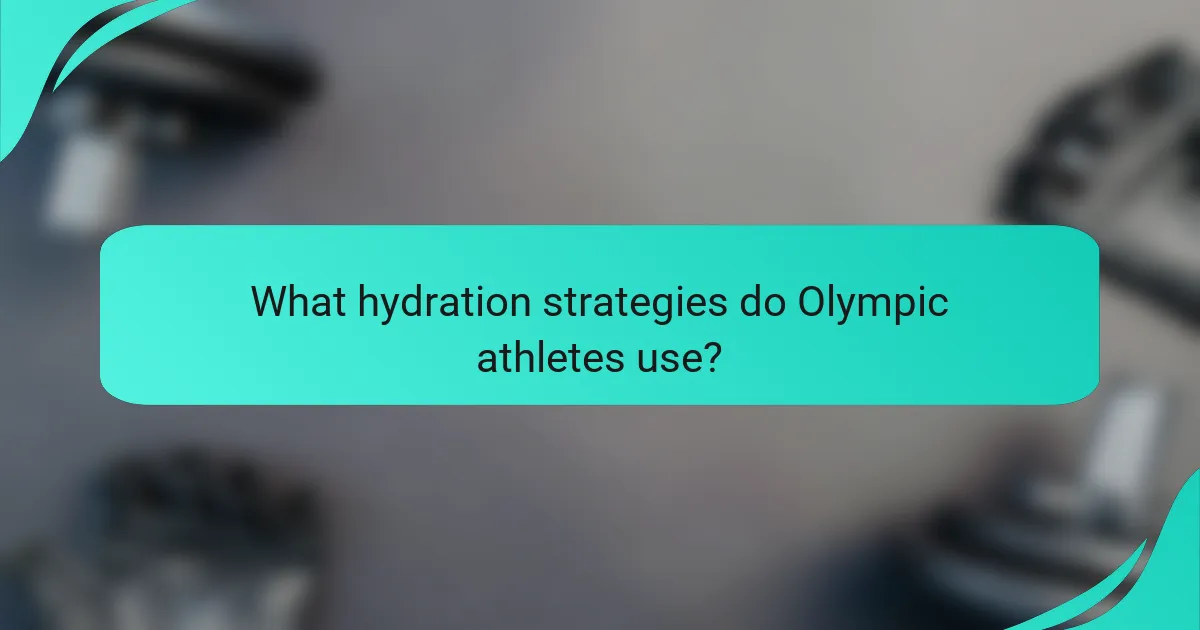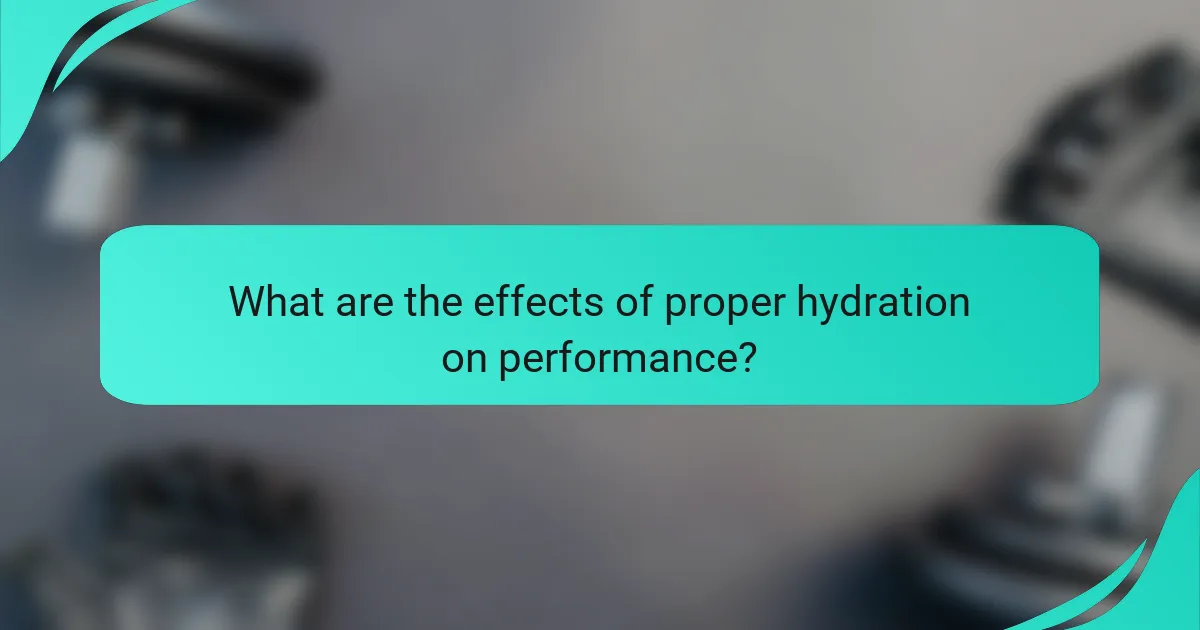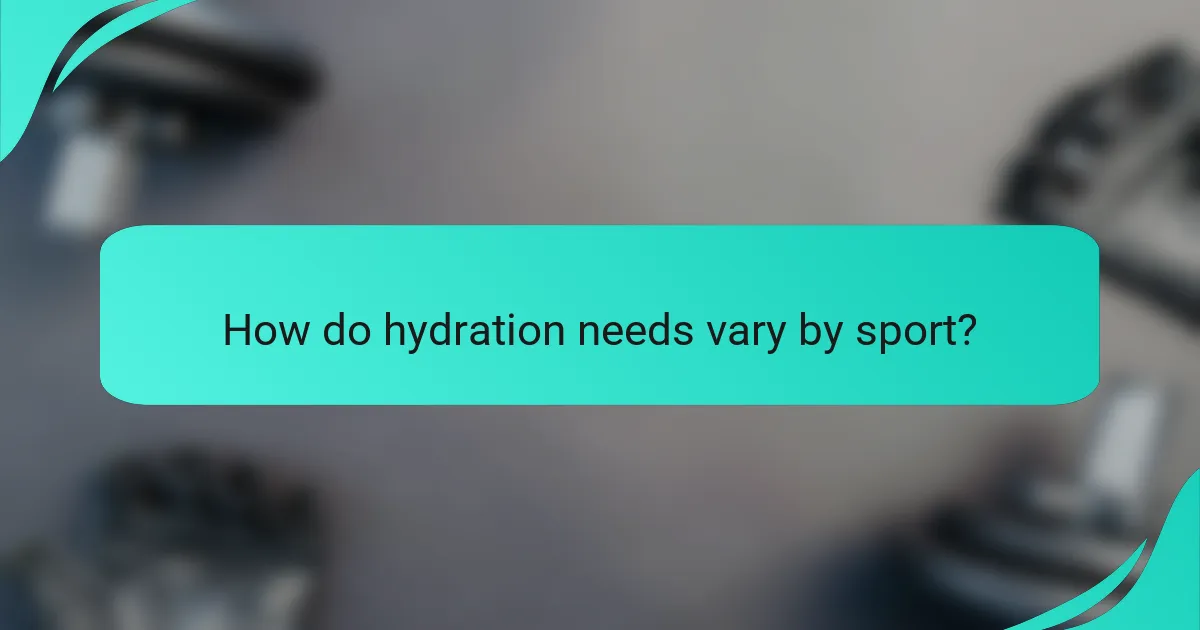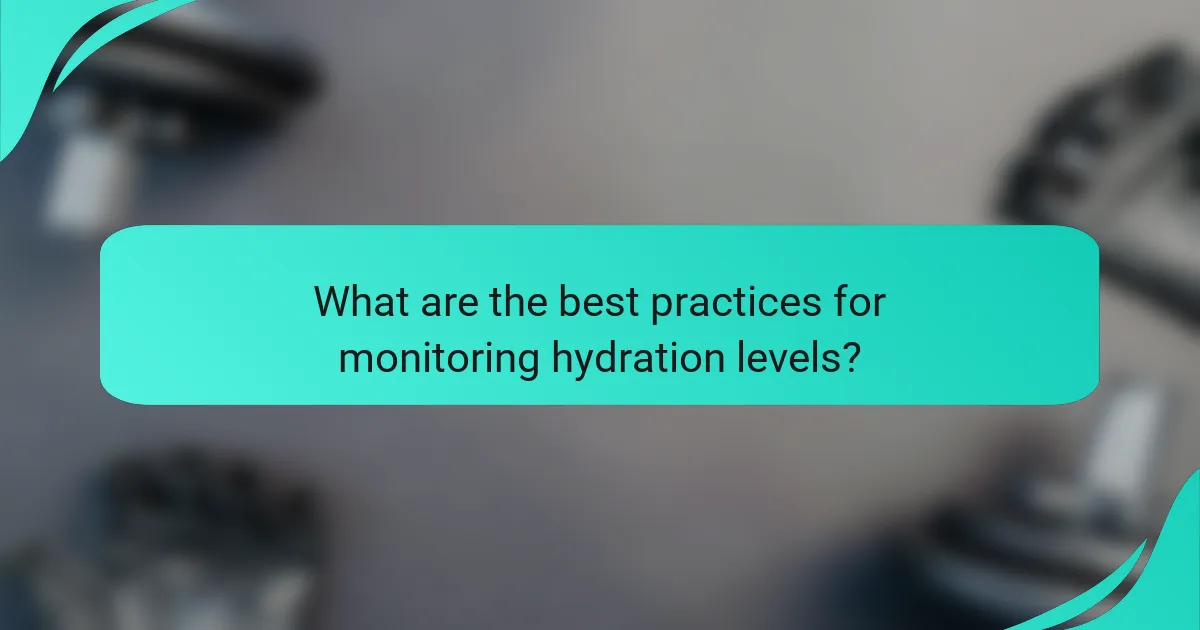Hydration is crucial for Olympic athletes to sustain peak performance and prevent dehydration. Utilizing a variety of methods such as electrolyte drinks, water intake, and hydration gels, athletes can effectively manage their fluid needs throughout training and competition. Consistent hydration before, during, and after events not only enhances endurance but also supports recovery and reduces injury risk.

What hydration strategies do Olympic athletes use?
Olympic athletes employ various hydration strategies to maintain optimal performance and prevent dehydration. These methods include electrolyte drinks, water intake, hydration gels, IV hydration, and sports drinks, each serving specific purposes during training and competition.
Electrolyte drinks
Electrolyte drinks are formulated to replenish essential minerals lost through sweat, such as sodium, potassium, and magnesium. These beverages help maintain fluid balance and muscle function, which is crucial during intense physical activity.
Athletes typically consume electrolyte drinks before, during, and after events, especially in hot conditions. It’s advisable to choose drinks with a balanced sodium content, often around 300-700 mg per liter, to effectively replace lost electrolytes.
Water intake
Water intake is fundamental for hydration, as it helps regulate body temperature and supports overall bodily functions. Athletes should aim to drink water consistently throughout the day, not just during training or competition.
As a general guideline, athletes might need about 2-3 liters of water daily, adjusting based on activity level and climate. Monitoring urine color can be a practical way to assess hydration status; pale yellow indicates proper hydration.
Hydration gels
Hydration gels provide a quick source of carbohydrates and electrolytes, making them ideal for endurance events. These gels are easy to carry and consume, allowing athletes to refuel without interrupting their performance.
When using hydration gels, athletes should pair them with water to aid digestion and absorption. Consuming one gel every 30-45 minutes during prolonged activities can help maintain energy levels and hydration.
IV hydration
IV hydration is sometimes used by athletes to quickly restore fluid and electrolyte balance, especially in cases of severe dehydration. This method delivers fluids directly into the bloodstream, providing rapid rehydration.
However, IV hydration should be used judiciously and typically under medical supervision, as it may not be necessary for most athletes. It is more common in recovery settings rather than during competitions.
Sports drinks
Sports drinks are designed to provide hydration along with carbohydrates and electrolytes, making them suitable for prolonged physical activity. These beverages can enhance endurance and performance by supplying energy and preventing fatigue.
Athletes should select sports drinks with a carbohydrate concentration of 6-8% for optimal absorption. Consuming these drinks during training sessions and competitions can help maintain energy levels and hydration status effectively.

When should Olympic athletes hydrate?
Olympic athletes should hydrate consistently throughout their training and competition schedule to maintain optimal performance. Proper hydration timing includes pre-competition, during training sessions, and post-exercise recovery to ensure athletes remain at their best.
Before competition
Hydration before competition is crucial for peak performance. Athletes should aim to drink fluids in the hours leading up to their event, typically around 500-600 ml about two to three hours prior. This helps to ensure that they start the competition well-hydrated, reducing the risk of dehydration during the event.
In addition to water, athletes may consider electrolyte drinks to replenish essential minerals lost through sweat. Monitoring urine color can also be a simple way to gauge hydration status; pale yellow indicates proper hydration, while darker shades suggest a need for more fluids.
During training
Hydration during training is essential to maintain energy levels and prevent fatigue. Athletes should drink fluids at regular intervals, ideally every 15-20 minutes, especially during intense sessions lasting longer than an hour. A general guideline is to consume about 200-300 ml of water or an electrolyte drink during these breaks.
For longer training sessions, incorporating a carbohydrate-electrolyte beverage can help sustain performance and enhance recovery. Athletes should tailor their fluid intake based on environmental conditions, such as heat and humidity, which can increase sweat loss.
Post-exercise recovery
Post-exercise hydration is vital for recovery and rehydration. Athletes should aim to drink approximately 1.5 liters of fluid for every kilogram of body weight lost during exercise. This can include water, electrolyte drinks, or recovery beverages that combine fluids with carbohydrates and proteins.
Consuming fluids soon after exercise helps to restore hydration levels and supports muscle recovery. Athletes should also consider consuming a balanced meal or snack that includes fluids, as this can further aid in rehydration and replenish energy stores.

What are the effects of proper hydration on performance?
Proper hydration significantly enhances athletic performance by optimizing physical capabilities and maintaining physiological functions. Staying adequately hydrated can improve endurance, aid recovery, and lower the risk of injuries during intense training or competition.
Improved endurance
Hydration plays a crucial role in sustaining endurance during prolonged physical activities. When athletes maintain fluid balance, they can delay the onset of fatigue, allowing for longer training sessions and improved performance in events. A common guideline is to drink about 500-700 mL of water or sports drink in the hours leading up to an event.
During exercise, consuming 200-300 mL of fluids every 15-20 minutes can help maintain hydration levels. This strategy is especially important in hot and humid conditions where sweat loss is significant.
Enhanced recovery
Proper hydration is essential for effective recovery post-exercise. Fluids help transport nutrients to muscles and remove metabolic waste, which can expedite the healing process. Athletes should aim to replace fluids lost during workouts, typically around 1.5 times the amount of weight lost during exercise.
Incorporating electrolytes in recovery drinks can further enhance the rehydration process, especially after intense training sessions. Consuming fluids within 30 minutes after exercise can maximize recovery benefits.
Reduced injury risk
Staying hydrated can significantly lower the risk of injuries, such as muscle cramps and strains. Dehydration can lead to decreased muscle function and coordination, increasing the likelihood of accidents. Athletes should monitor their hydration status by checking urine color, aiming for a pale yellow hue as a sign of adequate hydration.
To prevent dehydration-related injuries, athletes should establish a hydration plan tailored to their individual needs and environmental conditions. Regularly scheduled hydration breaks during training and competitions can help maintain optimal fluid levels.

How do hydration needs vary by sport?
Hydration needs differ significantly across sports due to variations in intensity, duration, and environmental conditions. Athletes must tailor their hydration strategies to meet the specific demands of their sport to maintain performance and prevent dehydration.
Athletics
Athletes participating in track and field events have diverse hydration needs based on the event’s duration and intensity. Short-distance sprinters may require less fluid than long-distance runners, who can lose substantial amounts of sweat over extended periods. It’s crucial for these athletes to hydrate before, during, and after their events, aiming for about 500-700 ml of fluid in the hours leading up to competition.
During events lasting over an hour, incorporating electrolyte-rich drinks can help maintain sodium levels and prevent cramping. Athletes should monitor their body weight before and after events to gauge fluid loss and adjust their intake accordingly.
Swimming
Swimmers often underestimate their hydration needs due to the cooling effect of water. However, they can lose fluids through sweat, even in a pool environment. To combat dehydration, swimmers should drink water or sports drinks before and after their sessions, aiming for about 200-300 ml every 15-20 minutes during practice.
It’s beneficial for swimmers to establish a routine for hydration, especially during long training sessions or competitions. Using a waterproof bottle or hydration system can help ensure they stay hydrated without interrupting their performance.
Cycling
Cyclists face unique hydration challenges, especially during long rides or races in hot conditions. They can lose significant amounts of fluid through sweat, necessitating a proactive hydration strategy. Cyclists should aim to drink approximately 500-1000 ml of fluid per hour, depending on the intensity and climate.
Incorporating electrolyte drinks can help replace lost salts, and cyclists should practice their hydration strategy during training to find what works best for them. Carrying a hydration pack or using water bottles mounted on the bike can facilitate consistent fluid intake throughout the ride.

What factors influence hydration strategies for athletes?
Hydration strategies for athletes are influenced by several key factors, including climate conditions, the duration of activity, and individual sweat rates. Understanding these elements helps athletes optimize their fluid intake for peak performance and recovery.
Climate conditions
Climate conditions play a crucial role in determining hydration needs. Hot and humid environments increase sweat loss, necessitating higher fluid intake to maintain hydration levels. Athletes training in cooler climates may require less fluid but should still monitor their hydration status to avoid dehydration.
For example, during summer training sessions, athletes might need to drink 1-2 liters of water per hour, while in milder temperatures, this could drop to 0.5-1 liter. Utilizing electrolyte drinks can also be beneficial in extreme heat to replace lost salts.
Duration of activity
The duration of physical activity significantly affects hydration strategies. Shorter workouts, typically lasting under an hour, may only require water for hydration. However, for prolonged activities exceeding an hour, athletes should consider electrolyte solutions to replenish lost minerals.
A common guideline is to drink approximately 500-700 ml of fluid for every hour of exercise beyond the first hour. This helps maintain performance and prevents fatigue, especially in endurance sports.
Individual sweat rates
Individual sweat rates vary widely among athletes and can significantly impact hydration strategies. Some athletes may sweat more profusely, losing fluids at a rate of over 1 liter per hour, while others may lose much less. Knowing one’s sweat rate can help tailor fluid intake accordingly.
A practical method to determine sweat rate is to weigh yourself before and after a workout, accounting for any fluid consumed. This can provide a clear picture of how much fluid needs to be replaced during training sessions. Adjusting hydration plans based on personal sweat rates can enhance performance and recovery.

What are the best practices for monitoring hydration levels?
Effective hydration monitoring for Olympic athletes involves regular assessment of fluid intake, urine color, and body weight changes. These practices help ensure athletes maintain optimal hydration, which is crucial for performance and recovery.
Fluid Intake Tracking
Keeping a detailed log of fluid intake is essential for athletes. They should aim to consume a specific volume of fluids before, during, and after training sessions. A common guideline is to drink around 500-700 mL of water or electrolyte drinks in the hours leading up to exercise, followed by 200-300 mL every 15-20 minutes during activity.
Using hydration apps or simple journals can help athletes track their consumption accurately. This practice can identify patterns and ensure they meet their hydration goals consistently.
Urine Color Assessment
Monitoring urine color is a quick and effective way to gauge hydration status. Athletes should aim for a pale yellow color, indicating adequate hydration. Darker urine suggests dehydration, while clear urine may indicate overhydration.
To standardize this method, athletes can use a urine color chart, which provides visual references for hydration levels. This simple tool can be carried during training and competitions for easy access.
Body Weight Changes
Regularly weighing before and after training sessions can help athletes assess fluid loss. A weight loss of more than 1-2% during exercise may indicate significant dehydration and the need for increased fluid intake.
To ensure accuracy, athletes should weigh themselves under consistent conditions, such as at the same time of day and wearing similar clothing. This practice helps track hydration trends over time and adjust strategies accordingly.
